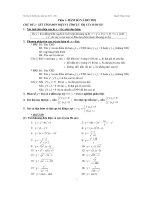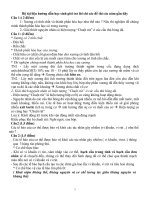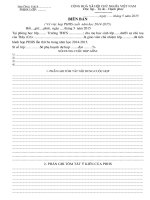tài liệu giảng dạy « website của đinh tiên minh phd
Bạn đang xem bản rút gọn của tài liệu. Xem và tải ngay bản đầy đủ của tài liệu tại đây (642.12 KB, 6 trang )
<span class='text_page_counter'>(1)</span><div class='page_container' data-page=1>
<b>Marketing Research</b>
Faculty of Marketing
School of International Business &
Marketing
<b>Reference Material</b>
<b>- Lecturing content rely mainly on the ESSENTIALS OF </b>
<b>MARKETING RESEARCH, Joseph F. Hair, Jr./ Mary Wolfinbarger</b>
Celsi/ David J. Oritinau/ Robert P. Bush
</div>
<span class='text_page_counter'>(2)</span><div class='page_container' data-page=2>
<b>Assessment</b>
<b>No</b>
<b>Assignment</b>
<b>Midterm Assessment</b>
<b>Group </b>
<b>Project</b>
<b>(50%)</b>
<b>(LMS)</b>
<b>Deadline</b>
<b>Of Group </b>
<b>Project</b>
<b>Diligence</b>
<b>(10%)</b>
<b>In-class </b>
<b>Assignment</b>
<b>(40%)</b>
1
Research topic
x
session 2
2
Research proposals
x
x
session 3
3
Sampling designing
x
x
session 4
3
Designing
questionnaires
x
x
session 5
4
Collecting data
session 6
5
Data analysis and
reporting
x
x
session 8
6
Presentation
x
x
session 9
<b>Subject content, objectives and activities </b>
<b>in class and LMS</b>
<b>Objective 3</b>
Research design &
Gathering data
<b>Objective 4</b>
Data analysis &
communicating
research findings
Statistic reviews
<b>Objective 1</b>
The role & value of
marketing research
Marketing research for
managerial decision
making
Marketing research &
marketing mix variables
The marketing research
process & Research
methodologies
<b>Objective 2</b>
Research
development
Identify and clarify
information needs
Specify research
objectives
Writing research
proposals
Identify and clarify
information needs
Specify research
objectives
Writing research
proposals
Identify and clarify
information needs
Specify research
objectives
Writing research
proposals
Identify and clarify
information needs
Specify research
objectives
Writing research
proposals
Identify and clarify
information needs
Specify research
objectives
Sampling theory &
methods
Measurement &
designing
questionnaire
Collecting data
Specify research
objectives
Specify research
objectives
Data processing by
SPSS
Specify research
objectives
Specify research
objectives
Research report &
</div>
<span class='text_page_counter'>(3)</span><div class='page_container' data-page=3>
Reading
<b>Essentials of marketing research book</b>
Chapter 1: Marketing research for managerial decision making
- Marketing research and marketing mix
- Marketing theory)
Chapter 2: The marketing research process and Proposals
- Overview of the Research Process
- Phase I: Determine the research problem
- Phase II: Select the research design
- Phase III: Execute the research design
- Phase IV: Communicate the results
Chapter 3: Secondary data, Literature reviews, and hypotheses
- Value of secondary data and literature reviews
- Conducting a literature review
- Internal and external of secondary data
Chapter 4: Exploratory and Observational research designs and data colletion approaches
- Value of qualitative research
- Overview of qualitative and quantitative research methods
- Observation methods
Chapter 5: Descriptive and causal research designs
- Value of descriptive and causal survey
- Descriptive research designs and survey
- Causal research designs
<b>Objective 1</b>
The role & value of
marketing research
Marketing research for
managerial decision
making
Marketing research anh
marketing mix variables
The marketing
research process &
Research
methodologies
<b>Subject content and activites in class and </b>
<b>LMS</b>
Reading Assignment
(In-class)
Project
(LMS)
<b>Essentials of marketing research book</b>
Chapter 2: The marketing research process
and Proposals
- Determining the need for information
research
- Phase I: Determine the research problem
Chapter 3: Secondary data, Literature
reviews, and hypotheses
- Develop a conceptual model
Chapter 5: Descriptive and causal research
designs
- Causal research designs
<b>Reviews:</b>
- Consumer behavior
- Marketing
- Identifying
Research
problem from
marketing
problems
- Developing
research
objectives
(and research
model) from
specific
research
problem
- Research topic
- Research
problem and
objectives
<b>Objective 2</b>
Research development
Identify and clarify
information needs
Specify research
objectives
</div>
<span class='text_page_counter'>(4)</span><div class='page_container' data-page=4>
Reading Assignment
(In-class)
Project
(LMS)
<b>Essentials of marketing research book</b>
Chapter 2: The marketing research process and
proposals
- Step 5: Develop the sampling design and
sample size
- Step 6: Examine measurement issues and
scales
- Step 7: Design and pretest the questionnaire
Chapter 6: Sampling theory and methods
Chapter 7: Measurement and scaling
Chapter 8: Designing the questionnaire
- Developing
sampling plan
for a research
project
- Designing
questionnaires
for a research
project
- Developing
sampling plan
for group’s
research project
- Designing
questionnaires
for group’s
research project
- Collecting data
for group’s
research project
<b>Objective 3</b>
Research design &
Gathering accurate
data
Sampling theory &
methods
Measurement &
designing
questionnaire
Collecting data
<b>Subject content and activites in class and </b>
<b>LMS</b>
Reading Assignment
(In-class)
Project
(LMS)
<b>Essentials of marketing research book</b>
Chapter 10: Preparing data for quantitative
analysis
- Editing and coding
- Data entry
- Data tabulation
Chapter 11: Basic data analysis for quantitative
research
- Value of statistical analysis
- How to develop hypotheses
- Analyzing relationships of sample data
- Comparing means: Independent versus related
samples
Chapter 12: Examining relationships in
quantitative research
Chapter 13: Communicating marketing research
findings
<b>SPSS textbook</b>
- Data analysis
by SPSS
- Analyzing
collected data
of group’s
research
project
- Writing
research
report
- Research
findings
presentation
<b>Objective 4</b>
Data analysis &
communicating
research findings
Statistic reviews
Data processing by
SPSS
Research report &
presentation
</div>
<span class='text_page_counter'>(5)</span><div class='page_container' data-page=5>
<b>LMS activities schedule</b>
<b>No</b> <b>Group Project</b> <b>Deadline</b>
<b>To submit </b>
<b>into LMS</b>
<b>Students (by group)</b> <b>Lecturer</b>
1 Research
topic
Sinh viênthảo luận theo nhóm và lựa chọn một
chủ đề nghiên cứu liên quan đến các hoạt động
marketing vànộp cho giảng viên thông quan
LMS những nội dung sau:
- Tênchủ đề nghiên cứu
- Chủ thể nghiên cứu (Product, Brand or
Marketing activities)
- Đối tượng nghiên cứu (Consumers
,Customers)
Góp ý chochủ đề nghiên cứu về:
- Tínhkhả thi của đề tài
- Phạm vi của đề tài (quá rộng hay quá
hẹp)
- Tênđề tài
session 2
2 Research
proposals
Dựa trên chủ đề nghiên cứu đã được chỉnh sửa,
sinh viênứng dụng các phương pháp nghiên
cứu tài liệu, thảo luận nhóm, nghiên cứu khám
pháđể phát triển:
- Vấn đề nghiên cứu: Nêu rõ mục đích của đề
tàinhằm giải quyết vấn đề marketing gì; dạng
thông tin mongmuốn cung cấp của đề tài (mô
tả, so sánh và quan hệ)
- Mục tiêu nghiên cứu và mơ hình nghiên cứu
(nếu có): Phát triển đầy đủ (theo cơ sở lý
thuyết và thực tế của lãnh vực nghiên cứu)
cácbiến số cần làm rõ
Góp ý:
- Vấn đề nghiên cứu: Sự rõ ràng của
dạng thông tin sẽ làm rõ sau nghiên
cứu (Mô tà, So sánh, Quan hệ)
- Mục tiêu nghiên cứu: Tính đầy đủ và
hợp lý của các biến số theo cơ sở lý
thuyết và tính thực tế
session 3
<b>LMS activities schedule</b>
<b>No</b> <b>Group Project</b> <b>Deadline</b>
<b>To submit </b>
<b>into LMS</b>
<b>Students (by group)</b> <b>Lecturer</b>
3 Sampling
designing
Sinh viênthiết kế kế hoạch chọn mẫu
chođề tài bao gồm:
- Xácđịnh các biến số thể hiện phần
tử và đơn vị mẫu
- Xácđịnh kích thước mẫu
- Phânbổ hạn ngạch và lập bảng theo
dõi
(Phương pháp chọn mẫu, cho phép sử
dụng phương pháp phi xác suất)
Góp ývề sự đầy đủ và tính hợp lý của các biến số
nhằm xác định phần tử mẫu và đơn vị mẫu
Góp ývề kích thước mẫu
session 4
4 Designing
questionn
aires
Dựa trên vần đề và mục tiêu nghiên
cứu sinh viên thiết kế phiếu điều tra thu
thập dữ liệu bao gồm:
- Phần gạn lọc đối tượng
- Phânnội dung nghiên cứu chính
- Phần thơng tin cá nhân người trả lời
Góp ý:
- Tínhđầy đủ của các phần trong phiếu điều tra
- Số lượng câu hỏi tương thích với các biến số
trongmục tiêu nghiên cứu
- Sử dụng thang đo phù hợp cho việc phân tích
thơng kênhằm cung cấp thơng tin (mơ tà, so
sanh và quanhệ) trong phần vấn đề nghiên
cứu
</div>
<span class='text_page_counter'>(6)</span><div class='page_container' data-page=6>
<b>LMS activities schedule</b>
<b>No</b> <b>Group Project</b> <b>Deadline</b>
<b>To submit </b>
<b>into LMS</b>
<b>Students (by group)</b> <b>Lecturer</b>
5 Collecting data - Dànhmột buổi cho sinh viên đi thu thập thơng tin ngồi thực địa Khơng có
6 Data analysis Sinh viên làmviệc trên phần mềm SPSS:
- Khái báocơ sở dữ liệu
- Nhập dữ liệu nghiên cứu vào máy tính
- Đổ bảng dữ liệu nghiêu cứu
- Phân tích cáckiểm định thống kê
7 Writing
research report
Sinh viêndựa trên dữ liệu đã phân
tíchviết báo cáo trên powerpoint và
nộp bảng báo cáo cho giảng viên
trên LMS
session 7
8 Presentation Sinh viên báo cáođề tài trước lớp - Giảng viên góp ý trực tiếp trên lớp Khơng có
9 Finalizing
research report
Sinh viênchỉnh sửa bổ sung báo cáo
vànộp báo cáo cuối cùng lên LMS
- Giảng viên chấm bài báo cáo cuối cùng
trên LMS (chiếm 50% số điểm môn học,
thaythế kỳ thi cuối mơn)
Sau ngày
thuyết trình 7
ngày
<b>Kết thúc!</b>
Faculty of Marketing
</div>
<!--links-->









